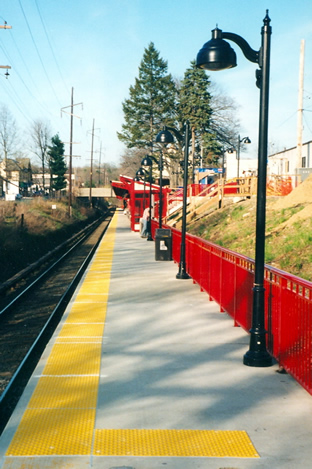GOVERNMENT REGULATIONS ON TACTILE WARNING SURFACES
The U.S. government enforces accessibility regulations through the Americans with Disabilities Act of 1990 (ADA), which protects the rights of people with disabilities. Additional regulations are based on the Architectural Barriers Act of 1968. The Architectural and Transportation Barriers Compliance Board (Access Board) has made recommendations on accessibility guidelines, namely those concerning public rights-of-way. Tactile warning surfaces from ADA Solutions adhere to these and the California Department of Transportation (Caltrans) standard plans.
REVISED: ADA Requirements For Detectable Warning Surfaces:
Accessible Public Rights-Of-Way (11/23/05)
To view the most recently revised guidelines published by the Access Board, go to their website.
These guidelines include a technical Q&A regarding alteration projects for curb ramps, sidewalks, and signals. The Access Board details terminology; requirements for buildings, facilities, and structures; pedestrian crossings; and directional, informational, and warning signs. It also covers guidelines for bus stops, on-street parking, use of detectable warning panels, and physical dimensions for installing panels to supplement ADA regs and California ADA ramp & curb specification requirements.
ADA Solutions products are compliant with Detectable Warning and Way Finding Specifications prescribed under:
- International Standards Organization – (ISO 23599)
- Americans with Disabilities Act – (ADAAG and PROWAG)
- California Title 24 / California Building Code (CBC) 2013
- Canadian Standards Organization – (CSA B651-12)
When it comes to installing a tactile warning surface, no one in the industry can match ADA Solutions for quality, reliability, quick delivery service, and compliance. Whether you’re updating existing construction or installing new ramps, curbs, sidewalks or other projects, we provide the solutions you need.
Products for All of Your New Construction Needs
Many local, state, and federal regulations governing new construction now require ADA compliance. ADA Solutions’ tactile warning surface products provide your company with the solutions you need to ensure safety and accessibility. We not only provide excellent quality products, but we also strive to ensure you have all the information you need for compliance. Our products exceed the most stringent requirements for water absorption; slip resistance; wear, weather, and chemical resistance; UV stability; detectability; and strength. Contact us today to discuss your new construction needs.
INDUSTRY-RELATED LINKS
ADA Guide Lines for Building Curbs
This includes the most recent title II ADA regulations implemented in 2016, which puts the responsibility of accessibility in the hands of state and local governments. The ADA’s guidelines define a curb ramp and its components and identify acceptable design specifications for warning surfaces and ADA flooring, such as:
- Slope: The slope of a curb ramp (built after January 26, 1992) must be 8.33% or less.
- Width: A ramp must be a minimum of 36 inches wide.
- Detectable warnings: Dome-shaped bumps must extend the ramp’s full width and depth.
- Transitions: Must be level with the street, walkway, or gutter.
- Location: Curb ramps must be anywhere a sidewalk or pedestrian path meets a curb.
U.S. Department of Transportation Memorandum
This provides an overview of the use of detectable warnings, per the ADA’s minimum design standards, with access to additional insights on truncated domes, their unique design, and effectiveness. The memorandum defines the U.S. Department of Transportation’s role in enforcing ADA Title II standards and regulations.
US Access Board
A federal agency promoting equality for those with disabilities, the U.S. Access Board assumes a leadership role in the development of accessibility guidelines. The Board has developed guidelines for street crossings, sidewalks, and shared use paths to improve accessibility and transportation and recreational safety in off-road areas. Guidelines cover slope, terrain, roadway design, and other factors.
Public Right of Way
This addresses proposed and current guidelines regarding ADA accessibility at public rights-of-way. The Access Board develops guidelines on street crossing access for visually impaired pedestrians, wheelchair access to street parking, and pedestrian access to curb ramps, crosswalks, and other public rights-of-way associated with an ADA compliant sidewalk.
California Building Standards Commission
This administers the state’s building codes development, adoption, implementation, and other processes. The California Building Standards Code, Title 24 covers the design, safety, construction, and sustainability of buildings in the state.
DSA California Compliance
This provides access to reference materials covering accessibility guidelines, which apply to government buildings, public housing, commercial facilities, and privately owned public https://adatile.com/wp-admin/post.php?post=1489&action=edit&classic-editor=1#saveaccommodations. Links to the Summary of 2016 California Building Code Changes for Accessibility and other resources are available.
Caltrans Standard Plans A88A
This has schematic details that represent the dimensional and physical requirements of a tactile surface on a curb ramp.
Caltrans Standard Plans A88B
This has schematic diagrams covering curb ramps and different types of island passageways.
APWA Report: Are Your Curb Ramps Really Compliant?
This is an article by the American Public Works Association, published in August 2008, that provides insights into ADA accessibility guidelines, including those covering building retrofits and using curb ramps with tactile tiles and other detectable warning panels. The report also emphasizes compliance as a goal for engineers, inspectors, contractors, and others.
Learn more about ADA Solutions’ tactile warning surfaces covered by ADA regs, and under Caltrans standard plans, by calling us toll-free at 800-372-0519, or request a free quote today.


